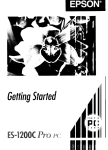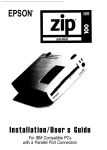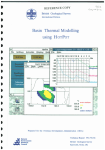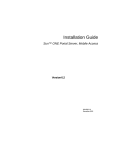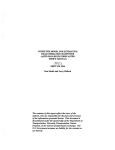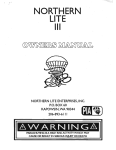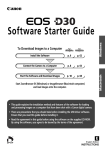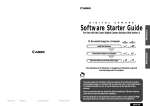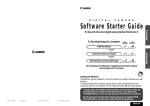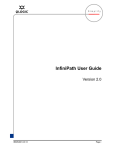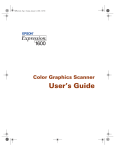Download Epson GT-8500 User`s guide
Transcript
EPSON® @a Printed on recycled paper with at least 10% post-consumer content A Nofe Concerning Responsible Use of Copyu-gh fedMaferials Like photocopiers, scanners can be misused by improper copying of copyrighted material. Although Section 107 ofthe U.S. Copyright Act of 1976 (Title 17, United States Code), the “fair use” doctrine, permits limited copying in certain circumstances, those circumstances may not be as broad as some people assume. Unless you have the advice of a knowledgeable attorney, be responsible and respectful by not scanning published material without the permission ofthe copyright holder. Copyu-gh f Notice All rights reserved. No part ofthis publication may be reproduced, stored in a retrieval system, or transmitted in any form or by any means, electronic, mechanical, photocopying, recording, or otherwise, without the prior written permission of Seiko Epson Corporation. No patent liability is assumed with respect to the use ofthe information contained herein. Neither is any liability assumed for damages resulting from the use ofthe information contained herein. Neither Seiko Epson Corporation nor its affiliates shall be liable to the purchaser ofthis product or third parties for damages, losses, costs, or expenses incurred by purchaser or third parties as a result of: accident, misuse, or abuse ofthis product or unauthorized modifications, repairs, or alterations to this product. Seiko Epson Corporation and its affiliates shall not be liable against any damages or problems arising from the use of any options or any consumable products other than those designated as Original EPSON Products or EPSON Approved Products by Seiko Epson Corporation. ES-1000C is a trademark of Epson America, Inc. EPSON is a registered trademark of Seiko Epson Corporation Copyright 0 1995 by Epson America, Inc. Torrance, California, USA 41 95 In troduc tion This package contains everything you need for professional quality color scanning: EPSON® ES-1000C’“color scanner, which scans in full color (30 bit) or grayscale monochrome (8 bit) SCSI interface card, which provides a SCSI interface for your IBM@ compatible computer SCSI interface cable Adaptec@EZ-SCSI version 3.0 software, which enables your computer to use the SCSI interface EPSON Scanning Utilities (EPSON Scan! II and EPSON TWAIN), which let you capture scanned images, export the images in a variety of formats, calibrate your scanner, and use the scanner’s advanced features with software programs that support the industry standard TWAIN interface Adobe@PhotoshopTMa powerful image-editing program that lets you merge and edit color images, retouch photographs, or create new artwork Xerox® Imaging Systems TextBridge,TM an optical character recognition (OCR) program for Microsoft@ WindowsTMthat converts hard copy and on-line images into formatted text. This booklet tells you how to set up your scanner, install the software, and scan an image. If you need more detailed information after you begin scanning, consult the individual manuals for the ES-1000C Scanner, EPSON Scanning Utilities, Adobe Photoshop, and TextBridge. System and Memory Requirements For the scanner hardware and software to work properly, your system must include the following minimum configuration: A 386-based (or higher) IBM@ compatible computer or an IBM PSI 2@ MS-DOS@version 5.0 or higher Microsoft Windows 3.1 or higher, or Windows NT 3.5-inch, high-density diskette drive At least 1OOMB of hard disk space for scanner applications and images 4MB of system RAM plus a permanent Windows swap file providing 8MB to 16MB of virtual memory (a swap file of contiguous space on your hard disk drive which Windows can use; see your Microsoft Windows manual) Note: 4A4B is the minimum amount ofRAM; graphics qplications run farter andmore efjciently with moreRAM. A mouse or other compatible pointing device A Video Graphics Array (VGA) or other Windows compatible display adapter card or built-in interface supporting at least 16 colors for simple color scanning. To adequately view an average-complexity color scan, the card or interface must support 256 colors, while high-quality, realistic color scans require a card supporting 16 million colors. A color monitor compatible with the card or interface you are using. Installing the SCSI Interface Card Follow the steps below to install the SCSI interface card in your computer. For additional information, see the manuals for your interface card and computer. If you are already using a SCSI adapter in your computer for other SCSI devices, such as an external hard disk, see Chapter I of the ES-1000C User's Guide for information on including the scanner in an existing SCSI daisy-chain. Note: Your SCSIadqter must be compatible with Adqtec EZ-SCSI software to use the EPSON Scanning Utilities that control your scanner. 1. Turn off the computer and any peripheral devices. 2. Disconnect the computer’s power cable from the electrical outlet and from the back panel. Also disconnect any other cables, including the keyboard cable. 3. Remove the cover from your computer. If you need detailed instructions, see your computer manual. 4. Before you touch any of the computer’s internal components, touch an unpainted metal surface inside the computer case to discharge any static electricity. 5. Choose an option slot for the interface card. You can install the card in any available slot. 6. Remove the retaining screw from the option slot cover and remove the slot cover. Keep the screw to secure the interface card to the computer. Store the slot cover in a safe place in case you remove the interface card later. 3 7. Unpack the interface card. When handling the card, be careful not to touch any of the components on the circuit board or the gold-edged connector. 8. Insert the card into the slot, guiding it straight down. Push the card down firmly (but carefully) to insert it fully. You should feel the card fit into place. 9. Secure the card to the computer with the retaining screw. 10. Replace the cover, reconnect all the cables, and plug the power cord into an electrical outlet. Setting Up the Scanner Follow these steps to set up the scanner: 1. Take the scanner out of its box and place it on a flat, stable surface with the rear panel facing you. 2. Remove the tape securing the scanner cover and pull out the paper underneath the cover. 3. Locate the round knob in the middle of the rear panel. 4. Turn the knob counterclockwise. If necessary, use a coin to loosen it. The knob has a built-in spring, so it pops out a little when it is released. You cannot remove the knob. 5. Connect one end of the power cable to the power inlet on the rear of the scanner and plug the other end into an appropriately grounded electrical outlet as shown below. If the scanner comes on when you plug it in, turn it off by pressing the OPERATE button. Warning: Whenever you turn off the scanner, wait at least 10 seconds before turning it back on. Rqidly turning it on md offcm damage the scanner. Connecting the Scanner to the Computer Follow the steps below to connect the scanner to your computer’s SCSI interface using the cable included with the scanner. 1. Turn off your computer, scanner, and any other peripheral devices. Caution: Be sure that your computer, scanner, md any other peripheral devices are turned off before you plug in the ccrble. 2. Connect one end of the SCSI cable to either the top or bottom SCSI connector on the scanner; then fasten the connector with the wire clamps on its side, as shown. 3. Connect the other end of the SCSI cable to the connector on the SCSI interface card you installed in the computer. Fasten the connector with the wire clamps. 4. Make sure the scanner’s internal SCSI terminator switch is turned on, as shown. 5. Make sure the SCSI ID switch is set to 2, as shown 6. Turn on the scanner by pressing the Operate button. 7. Turn on your monitor and all your other peripheral devices. Then turn on the computer. (Always turn on the scanner before the computer.) 7 Installing the EZ-SCSI Software If you are running Windows NT, you do not need to install EZ-SCSI or the EPSON Scanning Utilities; skip to “Installing Adobe Photoshop.” Follow these steps to install the Adaptec EZ-SCSI software: 1. Start Windows. 2. Insert the Adaptec EZ-SCSI Disk 1 in a diskette drive. 3. From the Program Manager, open the File menu and choose Run. The Run dialog box appears. 4. Type A: SETUP (or B: SETUP if you used drive B) in the Command Line box and choose OK. 5. Choose Install Adaptec EZ-SCSI. A screen appears identifying your SCSI interface card. Choose Continue 6. The next screen identifies the scanner as the GT-8500; this is normal. Choose Continue. 7. The Installation Subdirectory screen appears, prompting you for a directory for the EZ-SCSI program files. Choose Install to accept the default directory. The program copies the files. 8. Follow the instructions that appear on the screen to accept the EZ-SCSI default settings and insert each EZ-SCSI diskette. The program modifies the CONFIG.SYS file and saves a backup copy of the original as CONFIG.BAK. It also creates an Adaptec SCSI program group and its icons in Windows. 9. When the Installation Complete dialog box appears, choose Reboot System to restart the computer. 10. Remove the last installation diskette from the drive and choose Continue. Installing the EPSON Scanning Utilities The EPSON Scanning Utilities include EPSON Scan! II and EPSON TWAIN. Scan! uses TWAIN to capture images and then saves and exports these images in a variety of file formats. It also calibrates your scanner and output devices to produce images nearly identical to the originals. (A scanned color image never truly matches its original because scanned images are processed by a color system that is different from the process used to create original images.) EPSON TWAIN is a set of drivers designed to access your scanner’s advanced features for any software that supports TWAIN. TWAIN drivers are an industry standard for acquiring image data from a variety of external sources without leaving your application program. Follow these steps to install the EPSON Scanning Utilities: 1. Start Windows, if necessary 2. Insert the EPSON Scanning Utilities diskette in a diskette drive. 3. From the Program Manager, open the File menu and choose Run. You see the Run dialog box. 4. Type A: SETUP (or B: SETUP if you inserted the diskette in drive B) in the Command Line box and choose OK. 5. After a few moments, you see the initial setup screen. Choose OK to continue. 6. Choose OK to accept the default path name in which the program will install the utilities. 10 7. The next screen prompts you for the path name of the Windows directory. If the displayed path is correct, choose OK. (Otherwise enter the correct drive and directory.) The installation program copies the files to your hard disk drive. 8. When the Scanner Setup dialog box opens, click on the arrow in the Interface box. Select SCSI as the interface type. The program supplies the port ID, as shown below. 9. Now do a test scan. Raise the scanner’s cover and place an image face down on the glass surface. Then carefully close the cover. 10. Choose Test. If the scanner, SCSI interface, and EPSON Scanning Utilities are set up correctly, the scanner scans the image. After a few moments, the scanned image appears in the Scanner Setup dialog box, as shown below. ID 2 GT-8500 I 11. Choose OK to close the Scanner Setup dialog box. 12. Remove the EPSON Scanning Utilities diskette. 13. Exit and then restart Windows. Installing Adobe Photoshop To install Adobe Photoshop, you first install the program and then select the scanner as your acquire device, as described in this section. 11 Installing Photoshop Follow these steps to install Photoshop : 1. Start Windows, if necessary 2. Insert the Photoshop Installer-Disk 1 in a diskette drive 3. From the Program Manager, open the File menu and choose Run. You see the Run dialog box. 4. Type A: PSSETUP (or B: PSSETUP) in the Command Line box and choose OK. You see the Adobe Photoshop Installer dialog box, as shown below Adobe Photoshop ltm12.5 LE I The Adobe Photoshop Installer will install: Disk Space Required: -IKE Disk Space Available: -IKE Target directory for Adobe Photoshop files: C:\PHOTOSLE 12 5. Leave the Installation Options selected. If you are concerned about the disk space required for these options, consult the Photoshop manual for information on which options you can skip and the disk space they require. 6. Choose Install. You see the registration screen. 7. Enter your name, organization (optional), and the serial number of the program. You’ll find Photoshop’s serial number inside the front cover of the Photoshop manual. 8. Choose OK. Then follow the instructions as they appear on the screen, choosing OK to continue the installation, as necessary. 9. When you see a message that the installation is complete, choose OK to return to the Program Manager. 10. Remove the final installation diskette from the drive. The installation program creates an Adobe program group containing the Photoshop icons. Selecting the Acquire Device Before you can scan an image with Photoshop, you need to select the scanner as the acquire device. Follow these steps: 1. From the Program Manager, open Photoshop by double-clicking on its icon in the Adobe program group. 2. Choose Acquire in the File menu and then choose Select TWAIN Source. You see the following dialog box: 13 3. Highlight Epson Scanners if it is not already highlighted 4. Choose Select to specify the scanner as the acquire device. 5. Select Exit from the File menu to return to the Program Manager. You only need to select the scanner as the acquire device the first time you set up Photoshop and if you change the acquire device. Installing TextBridge To install TextBridge OCR for Windows, you must install the program and then tell TextBridge which scanner you are using Installing the Program Follow these steps to install TextBridge: 14 1. Start Windows, if necessary 2. Insert the TextBridge Disk 1 diskette in a diskette drive. 3. From the Program Manager, open the File menu and choose Run. You see the Run dialog box. 4. Type A: SETUP (or B: SETUP) in the Command Line box and choose OK. After a few moments, you see the initial setup screen. Choose Continue. 5. When prompted to accept the default path for the TextBridge software, choose Continue. 6. At the next screen, select one or more language packs and choose Continue. 7. Follow the instructions as they appear on the screen for inserting the other TextBridge diskettes and choose OK. 8. When you see a message telling you that the installation is complete, choose OK. 9. Remove the final installation diskette from the drive. The installation program creates a TextBridge OCRprogram group and icons. Identifying the Scanner to TextBridge Now you need to identify the scanner to TextBridge. Follow these steps: 1. In the TextBridge OCR program group, double-click on the Scanner Setup icon. You see the Scanner Setup screen. 2. From the Type menu, choose TWAIN. 3. From the File menu, choose Select Source. 4. Highlight Epson Scanners, if it is not already highlighted, and choose Select. 5. Choose Exit from the File menu to return to the Program Manager. You only need to select the scanner the first time you set up TextBridge. 15 Scanning Images Now you are ready to start scanning. First, choose an image to scan. The best choice is a color photograph. Printed pictures, such as those in magazines, do not scan as well as photographs because of the dot patterns used in the printing process. When selecting an image or text to scan, respect the rights of the copyright holders. Don’t scan published materials without first checking the copyright status. After you choose an image, follow these steps to scan it: 16 1. Double-click on the Photoshop icon in the Adobe program group, if the program is not already running. 2. Raise the document cover on the scanner and place the image face down on the glass surface. 3. Carefully close the document cover so that you do not disturb the position of the photograph on the glass. 4. Choose Acquire in the File menu; then choose TWAIN. You see the EPSON TWAIN dialog box. 17 5. In the scroll bar next to the Image Type button, select the image type appropriate for your scan. If you are scanning a color photograph, select Color Photo. 6. , at the bottom of the Click on the full-page Preview icon , dialog box. This does a fast preview scan so you can see the scan area. q You see a preview of your image at the right. To define the area you want to scan, position the mouse at the corner of the area; then hold down the mouse button as you drag it to the opposite corner of the area. To define the entire image area, click on the Auto Locate To change the selected image area, move the pointer to the edge of the selected area; then hold down the mouse button and drag the edge of the rectangle to a new location. 18 7. Select Scan. In a few moments, the scanned image is imported into the Photoshop window. 8. To see the scanned image, select Close to exit EPSON TWAIN and close its dialog box. Putting It Together Once you have scanned images and text, you can put them together in reports, newsletters, brochures, presentations, or a myriad of formats. Several factors affect how closely your scanned image reflects the original, especially when you print the images on paper. The next sections discuss basic calibration techniques and resolution settings you can use in EPSON Scan! II to help you achieve the results you want. See your EPSON Scanning Utilities User’s Guide for inform ation on other, more sophisticated methods of modifying your scan. 19 Calibrating Your System Calibration allows you to match your scanner and your output device so you can reproduce color images that are very close to the originals. Because monitors use a different method to display color images than printers use to print them, images look different when displayed and when they are printed. Also, each output device may produce different printed results. For example, an image printed on an electronic color printer looks dramatically different when printed on a printing press. EPSON Scan! II calibrates your scanner with your monitor, application, and printer by analyzing the results of a calibration sample at each stage of the process. The basic calibration process consists of: 0 Calibrating your monitor to your scanner 0 Enabling screen calibration 0 Exporting a calibration chart to your application 0 Creating calibration profiles for your printers 0 Scanning using the calibration profile. These procedures are described in the following sections. Calibrating your monitor to your scanner Follow these steps to calibrate your monitor to your scanner: 1. 20 From the Program Manager, double-click on the EPSON Scan! II icon in the EPSON Scanner program group. 2. Choose Screen Calibration from the Calibrate menu. You see this screen: Adjust the slider below until the gray areas appear the same. 3. Look at the display from a distance and adjust the slide bar until the separate rows have the same basic color intensity. 4. Choose OK. Enabling screen calibration Now follow these steps to make sure screen calibration is enabled: 1. From the File menu, choose Acquire to start EPSON TWAIN. 2. Select Configuration; you see the Configuration dialog box. 3. Make sure the Enable Screen Calibration check box is checked. If it isn’t, select it to enable screen calibration. 4. Choose OK. 5. Select Close to exit EPSON TWAIN. 21 When screen calibration is enabled, TWAIN uses it as it scans images until you change this setting. Note: If you change to a different monitor, you will need to create anew screen calibration projle. Do this by selecting Ca Ii bra tion Profile in the Conjguration dialog box. The new screen calibration projle overrides the old one. Exporting a calibration chart Follow these steps to export a calibration chart from Scan! II to your application: 1. From EPSON Scan! II, choose Export Calibration Chart from the Calibrate menu. You see the following screen: This function calibrates your scannerlapplicationlprinter system by passing a calibration sample throuqh each staqe and analyzinq the results. Select a file format you &n import into the soft&& you plan to use. Import the resulting Calibration Chart file into your software and print it on your printer. Then return to EPSON Scan! II and select ‘Create Calibration profile . ..’ from the ‘Calibrate’ menu. 22 File Name: Directories: Eile Format: Driyes: 2. In the File Format pull-down menu, select the .BMP file form at. 3. In the File Name field, type the name (such as COLORl.BMP) you want to use for the calibration chart file. 4. Choose OK to export the calibration chart. 5. Exit EPSON Scan! II. 6. Start Photoshop by double-clicking on its icon in the Adobe program group. 7. Open the calibration chart file you exported. The chart contains nine blocks of color gradations surrounded by a black border on three sides and some grayscale gradations on top. 8. Save the calibration chart file within Photoshop by selecting Save from the File menu. 9. Print the calibration chart on your color printer. If you have more than one printer, print the calibration chart on each one. Creating printer calibration profiles Follow these steps to create a calibration profile for each printer: 1. Start EPSON Scan! II, if necessary 2. Place the printed calibration chart face down on the glass surface of the scanner. 3. Choose Create Calibration Profile from the Calibrate menu You see the following screen: Description: Your Printer 23 4. In the File Name field, type the file name of the calibration file you want to create, such as COLORl.CAL. Make sure you use the .CAL file extension. 5. In the Description field, type a short description of the printer for which you created this calibration chart, such as Color Printer 1. 6. Choose Continue. You see the EPSON TWAIN screen. 7. If necessary, select Color Photo from the Image Type pull-down menu. 8. Select Calibration Profile from the Destination pull-down menu. 9. Choose the Scan icon. The program scans the calibration chart and creates a calibration profile. You see the main Scan! II program screen. Now you can use this calibration profile when you scan images. Scanning using calibration Follow these steps to use a calibration profile when you scan: 24 1. Choose Acquire from the File menu of EPSON Scan! II or Photoshop. (If you are using Photoshop, then select TWAIN.) You see the EPSON TWAIN screen. 2. Choose the Destination button; you see the Destination dialog box. 3. In the Destination Name field, type a name for the calibration profile, such as Color 1 Profile. 4. Then select the Calibration pull-down menu and select the description of the printer you used when you scanned the profile (for example, Color Printer 1). 5. Choose Add 6. Choose OK. You see the EPSON TWAIN screen. 7. Now scan your image by choosing the Scan or Auto Scan button. The scanner scans the image using the information in the calibration profile to produce the best possible image for your printer. SelectingtheCorrect Resolution To select the best resolution for scanning an image, you must consider three factors: 0 Type of image you are scanning 0 Final output device type 0 Acceptable file size. You’ll select different resolutions for scanning line drawings and halftones from the ones you select for scanning photographs. The final output device is the device on which you plan to ultimately print the image. This may be a printer connected to your computer or a commercial printing press. In addition, the file size of the scanned image may determine the resolution you select. The file size may be very large for high resolution scans, taking up valuable disk space and causing longer processing or printing time. Generally, the higher the resolution you choose, the larger the file. 25 Note that a very high resolution scan may not produce a better-quality printed image because your output device may not recognize the high resolution information stored in the file In other words, there is no point in scanning at a higher resolution then your output device is capable of. To keep file sizes manageable, select the lowest resolution that provides acceptable quality on your output device. To scan at the optimum resolution for your image and final output device, select your resolution based on the recommendations in the table below. The resolutions are listed in dots per inch (dpi) or pixels per inch (ppi). Recommended resolutions Output device Line art Grayscale Color Black and white printer 300-600 80-1 70 Desktop or office color printer 300-720 150-240 150-240 Printing press or image setter 600-1 200 150-350 150-350 You can change resolutions using EPSON TWAIN by choosing the Destination button. In the Destination dialog box, select the box beneath the resolution type you want to change (Drawing/Halftone or Photo); then choose the resolution for that type from the pull-down menu. For more information on resolution, see your scanner User 's Guide and the EPSON Scanning Utilities User 's Guide. Now that you know the basics, you’re ready to begin scanning. For additional information, see the manuals for your scanner, the scanning utilities, Photoshop, and TextBridge. 26




























